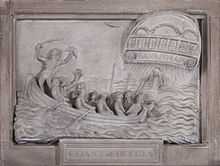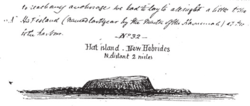HMS Havannah (1811)
| Career (United Kingdom) | |
|---|---|
| Name: | HMS Havannah |
| Builder: | Wilson & Co., Liverpool |
| Launched: | 1811 |
| Fate: |
Training ship 1860 Sold for breaking 1905 |
| General characteristics | |
| Class and type: | Apollo-class frigate |
| Tons burthen: | 948 64⁄94 bm (as designed) |
| Length: | 145 ft 0 1⁄2 in (44.2 m) (gundeck) 121 ft 9 1⁄4 in (37.1 m) (keel) |
| Beam: | 38 ft 3 1⁄4 in (11.7 m) |
| Draught: | 13 ft 3 3⁄4 in (4.1 m) |
| Sail plan: | Full-rigged ship |
| Complement: | 264 |
| Armament: | Upper deck: 26 × 18-pounder guns QD: 2 × 9-pounder guns + 10 × 32-pounder carronades Fc: 2 × 9-pounder guns + 4 × 32-pounder carronades |
HMS Havannah was a Royal Navy 36-gun fifth-rate frigate. She was launched in 1811 and was one of twenty-seven Apollo-class frigates. She was cut down to a 24-gun sixth rate in 1845, converted to a training ship in 1860 and sold for breaking in 1905.
War service
Havannah 's first captain was George Cadogan, who commissioned her into the Channel Fleet. Havannah was rapidly involved in operations against French coastal shipping off the Channel Islands.
On 6 September 1811, the boats of Havannah, under the command of her first lieutenant William Hamley, landed a party that spiked the three 12-pounder guns of a battery on the south-west side of the Penmarks. They then brought out several coasting vessels that had taken refuge under the guns, all without taking any losses.[1]
- Schooner Aimable Fanny, laden with wine and brandy, and several chasse marees:
- St. Jean, laden with salt;
- Petit Jean Baptiste, laden with wine and brandy;
- Buonaparte, laden with wine and brandy;
- Voltigeur, laden with wine and brandy; and
- lastly, one of unknown name, laden with wine and brandy, dismantled and set on fire but later extinguished.
On 25 December Havannah sailed for the Mediterranean.[2] In 1812, Cadogan took Havannah to join the squadron operating in the Adriatic from the island of Lissa. On 24 April 1812 Apollo, Eagle and Havannah landed Lieutenant-colonel George Duncan Robertson, his staff and a garrison at Port St. George on Lissa.[3] The British had defeated a French naval force on 13 March at the Battle of Lissa and wanted to establish a base there with Robertson as its first Governor.

In early 1813 Havannah was detached to the Northern Italian coast where she a five-month campaign on the shipping and shore facilities of Vasto and its environs. On 6 January 1813 Havannah 's boats cut out Gunboat No. 8, armed with one long 24-pounder gun. She had a crew of 35 men under the command of M. Joseph Floreus, Enseigne de Vaisseau. Despite meeting a superior force and coming under small arms fire from the shore, the boats, under Lieutenant Hamley, captured the gunboat and three merchant vessels, their original target, as well. The British had one man killed and two men wounded in the operation.[4] In May 1821, prize money for the gunboat, the three merchant vessels St Antonio No. 1, St Antonio No. 2 and St Antonio No. 3 was awarded, as well as prize money for two other vessels taken that day, the Madona del Rosario and the settee Euphemia.[5] On 14 January Havannah and Milford captured two small trabacolos.[5]
Three weeks later, on 7 February, Havannah destroyed four gunboats at Manfredonia. In numerous actions, she seized dozens of ships and destroyed coastal batteries. For instance, on 22 March 1813 the ship's boats captured one trabaccolo, armed with three 9-pounder guns and destroyed another, at Vasto. Then on 26 March, her boats brought out five armed trabacolos and five feluccas laden with salt that had been run up on the beach near the town of Fortore. In both actions the enemy lost at least one man killed, while the British had only two men wounded in all.[6] In May 1821 prize money for ten trabaccolos, one parenza, five feluccas, and their cargoes, captured between 22 March and 5 May, was paid.[5]
On 18 July, while off Manfredonia, Havannah, with the sloop Partridge, attacked a small convoy and captured or destroyed all the vessels. They captured one Neapolitan gunboat armed with one 18-pounder gun, and burnt another. They also destroyed a pinnace armed with one 6-pounder gun. Lastly, they captured two trabaccolos armed with three guns each and laden with salt, and destroyed two others of the same strength and cargo.[7][Note 1]
In November 1813, Havannah was attached to Thomas Fremantle's squadron that blockaded and besieged Trieste. She was then detached to take the port of Zara with the assistance of Weazel (or Weazle). Cadogan used the ships' guns to establish batteries armed with two 32-pounder carronades, eight 18-pounder guns and seven long 12-pounder guns.[9] He then attacked the city and captured it with the aid of some Austrian troops. In all, they captured 110 guns and 18 howitzers, 350 men, 100 dismounted guns and 12 gunboats.[10] Cadogan was later instructed to hand over all prizes and spoils of war to the Austrians. (This order cost the crews of Havannah and Weazle an estimated £300,000 in prize money.) The Emperor of Austria, however, awarded Lieutenant Hamley the Imperial Austrian Order of Leopold for his services at Zara.[11]
On 9 December Havannah and Weazel destroyed 17 gunboats.[Note 2]
In 1814 Havannah came under the command of Captain James Black (acting.[13] On 6 February 1814, Apollo and Havannah were anchored outside Brindisi while the French frigate Uranie was inside the port, on fire. Cerberus had chased her into the port some weeks earlier while awaiting the officials of the port, which belonged to the Kingdom of Naples, to respond to the presence of the French vessel. When Apollo appeared on the scene and made signs of being about to enter the port, Uranie 's captain removed the powder from his ship and set her on fire.[14][Note 3]
On 15 April 1814, days before the end of the war, Havannah, under the command of (temporary) Captain Edward Sibly, captured the French privateer schooner Grande Isabelle off Corfu, together with the schooner's prize. The schooner carried four guns and 64 men and had sailed from Corfu on 9 April, before capturing a vessel sailing from Trieste to Messina.[16][Note 4]
Captain Gawen Hamilton recommissioned Havannah in April 1814 at Portsmouth.[13] On 19 July 1815, Havannah was in company with Sealark, Rhin, Menelaus, Fly and Ferret when they captured the French vessels Fortune, Papillon, Marie Graty, Marie Victorine, Cannoniere, and Printemis. One was a naval brig of 12 guns and one a cutter of ten guns; two were schooners and three were chasse marees.[18][Note 5][Note 6]
Peace-time service
In 1815 Havannah sailed for North America, but by 12 August 1815 she was part of the squadron accompanying Northumberland, which was carrying Napoleon to exile in Saint Helena.[21] In 1816 Havannah sailed to the Cape of Good Hope.
By 1819 Havannah was laid up at Sheerness. She underwent repairs between April 1819 and October 1822.[13] From November 1821 she was again in commission and then was based in the Mediterranean. In 1830 she was in Sheerness.

In 1845 she was cut down to a 24-gun sixth rate corvette carrying 32-pounder (40cwt) guns.
In February 1848 Captain J.E. Erskine took command.[2] She then served on the New Zealand station between 1848 and 1851. She anchored twice in the sea between Efate, Lelepa, and Moso in Vanuatu, called Havannah Harbour after the ship.
She returned to Britain via Rio de Janeiro. She arrived at Devonport from Portsmouth on 7 December 1851. While approaching Britain, on 2 December she rendered assistance to the French ship Celine. Almost two years later her crew received an award of money for their services.[Note 7]
Captain T. Harvey took command in August 1855.[2] Under him, Havannah served with the Pacific Station from 1855 to 1859.[23] Havannah Channel in those waters is named for the ship, Port Harvey for its captain.
Fate
In 1860 Havannah was sent to Cardiff to serve as a "ragged school ship". She was sold for breaking up in 1905.[13]
Footnotes
- Notes
- ↑ In May 1821 prize money was paid for one trabaccolo and one paranza, laden with salt, captured that day.[5] In 1822 head money was paid for "Gunboats No. 1, 2 and 3".[8]
- ↑ A first-class share of the prize money was worth ₤197 17s 9½d; a sixth-class share was worth ₤1 16s 8d.[12]
- ↑ A first-class share of the head money for the destruction of the Uranie was worth ₤159 9s 7¾d; a sixth-class share was worth ₤1 0s 8½d.[15]
- ↑ A first-class share of the prize money was worth ₤75 2s 5d; a sixth-class share, that of an ordinary seaman, was worth 11s 11¾d.[17]
- ↑ The naval brig may have been Cannoniere, or more correctlyCannonierre NO. 21. Fouache & Reine, of Honfleur, had built her; she was launched on 7 August 1793 as Inquiète, and renamed in March 1803. She was a gun-brig of 170 tons (French) displacement, and had originally been armed with three 24-pounder guns and 12 swivel guns.[19]
- ↑ A first-class share of the prize money was worth ₤55 18s 4½d; a sixth-class share was worth 10s 10¾d.[20]
- ↑ A fifth-class share was worth ₤13 5s 6d.[22]
- Citations
- ↑ The London Gazette: no. 16523. p. 1829. 17 September 1811.
- ↑ 2.0 2.1 2.2 "NMM, vessel ID 368279" (PDF). Warship Histories, vol i. National Maritime Museum. Retrieved 30 July 2011.
- ↑ Pocock (1977), p.184.
- ↑ The London Gazette: no. 16740. pp. 1148–1149. 12 June 1813.
- ↑ 5.0 5.1 5.2 5.3 The London Gazette: no. 17704. p. 1003. 8 May 1821.
- ↑ The London Gazette: no. 16758. pp. 1145–1486. 27 July 1813.
- ↑ The London Gazette: no. 16813. p. 2340. 23 November 1813.
- ↑ The London Gazette: no. 17791. p. 286. 16 February 1822.
- ↑ The London Gazette: no. 16843. p. 122. 11 January 1814.
- ↑ The London Gazette: no. 16888. p. 858. 23 April 1814.
- ↑ The London Gazette: no. 17018. p. 1042. 3 June 1815.
- ↑ The London Gazette: no. 17051. p. 1671. 15 August 1815.
- ↑ 13.0 13.1 13.2 13.3 Winfield (20080, p.168.
- ↑ The London Gazette: no. 16876. p. 700. 2 April 1814.
- ↑ The London Gazette: no. 17389. p. 1478. 18 August 1818.
- ↑ The London Gazette: no. 16919. p. 1487. 23 July 1814.
- ↑ The London Gazette: no. 17049. p. 1621. 8 August 1815.
- ↑ Lloyd's List, No.4990, - accessed 2 February 2014.
- ↑ Winfield and Roberts (215 forthcoming), Chap. 9.
- ↑ The London Gazette: no. 17229. p. 613. 11 March 1817.
- ↑ Lloyd's List, no. 4996, - accessed 2 February 2014.
- ↑ The London Gazette: no. 21488. p. 2885. 25 October 1853.
- ↑ BC Names/GeoBC entry "Hull Island"
References
- James, William (1827) The Naval History of Great Britain, Volume 6 (1811–1827). (London, Printed for the Author). 0-85177-909-3.
- Winfield, Rif. British Warships in the Age of Sail, 1793-1817: Design, Construction, Careers and Fates. Seaforth Publishing, 2nd edition, 2008. ISBN 978-1-84415-717-4.
External links
This article includes data released under a Creative Commons Attribution-ShareAlike 3.0 Unported UK: England & Wales License, by the National Maritime Museum, as part of the Warship Histories project